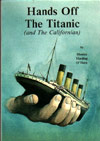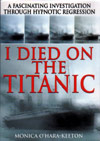|
| To Search This Site Enter Key Words Into Text Field On The Right and Hit The Search Button |
|
|
Monica (Harding) O'Hara-Keeton.
 |
O’Hara, Monica Harding. Hands Off the Titanic (and the Californian). 1st printing. Merseyside, England: Countryvise Limited. 1989. wraps. isbn: 0907768288. scarcity: very scarce.
The author uses handwriting analysis to attempt to peak into the minds and motives of some of the people who were involved in the Titanic story by analyzing samples of their handwriting. She attempts to determine if the myths surrounding many of these personalities are true. Was Ismay really a snob? Was Captain Smith as affable as history records him? Was Captain Lord purposefully maligned by his officers’ testimony?
Being an amateur handwriting analyst myself, I was particularly looking forward to this book, combining two of my favorite subjects, handwriting and Titanic.
In the course of her book, O’hara covers a wide selection of people involved with the story. Captain Smith, Second Officer Lightoller and Fourth Officer Boxhall are the officers covered. She also looks at White Star president J. Bruce Ismay, as well as Harland & Wolff luminaries, Lord Pirrie and Thomas Andrews. There are samples of members of the crew, like Benjamin Kirk, and Frederick Fleet, and the Marconi operators Harold Bride and Jack Phillips. Finally, there is a wide range of interpretations of passengers from all classes, including Sir Cosmo Duff Gordon, John Jacob Astor, Archibald Gracie, Lawrence Beesley, Edith Russell, Pastor John Harper and Eugene Daly just to name a few.
Though the concept for this book was innovative, it suffers from the author’s lack of quality handwriting samples to analyze. In order to accurately interpret these people’s inner personalities, samples from around the time of the disaster are crucial. Unfortunately, many of the samples shown were written many years later.
Even when she has samples from the right time period, they are often limited to just a signature, which is not always an accurate representation of the writer’s actual state of mind. Her analyses based on signatures are highly debatable at the very least.
One subject on which she did have quality samples written at the time of the disaster were of the officers on the Californian, particularly Lord, Stone and Gibson. The author makes no secret of the fact that she is a staunch supporter of Captain Lord, and my impression is that her zeal shaded her interpretations of these writing samples.
Her interpretation of Gibson’s sample seems particularly unfair. She describes it as ‘a secretive, pretentious and thoroughly awkward hand’. My take on the sample could not be more different. Gibson’s writing is one of the most readable in the entire book. Gibson not only believed what he was writing, he really wanted to share his information with the reader. His information might be wrong, but it was what he honestly believed to be true.
Aside from my reservations about the Californian samples, the author obviously made a genuine effort to work with what was available to her. Without quality 1912 samples though, many of her conclusions have to be considered speculative at best.
|
 |
O’Hara-Keeton, Monica . I Died on the Titanic. 1st printing. Rock Ferry, Birkenhead: Countyvise Limited, Pharoah Press. 1996. wraps. isbn: 0907768865. scarcity: scarce.
The subtitle on the front cover reads: A Fascinating Investigation through Hypnotic Regression.
There may, or may not have been a reprint edition in 1998. The information on the new book sites is not at all clear.
|
|
|
|
|